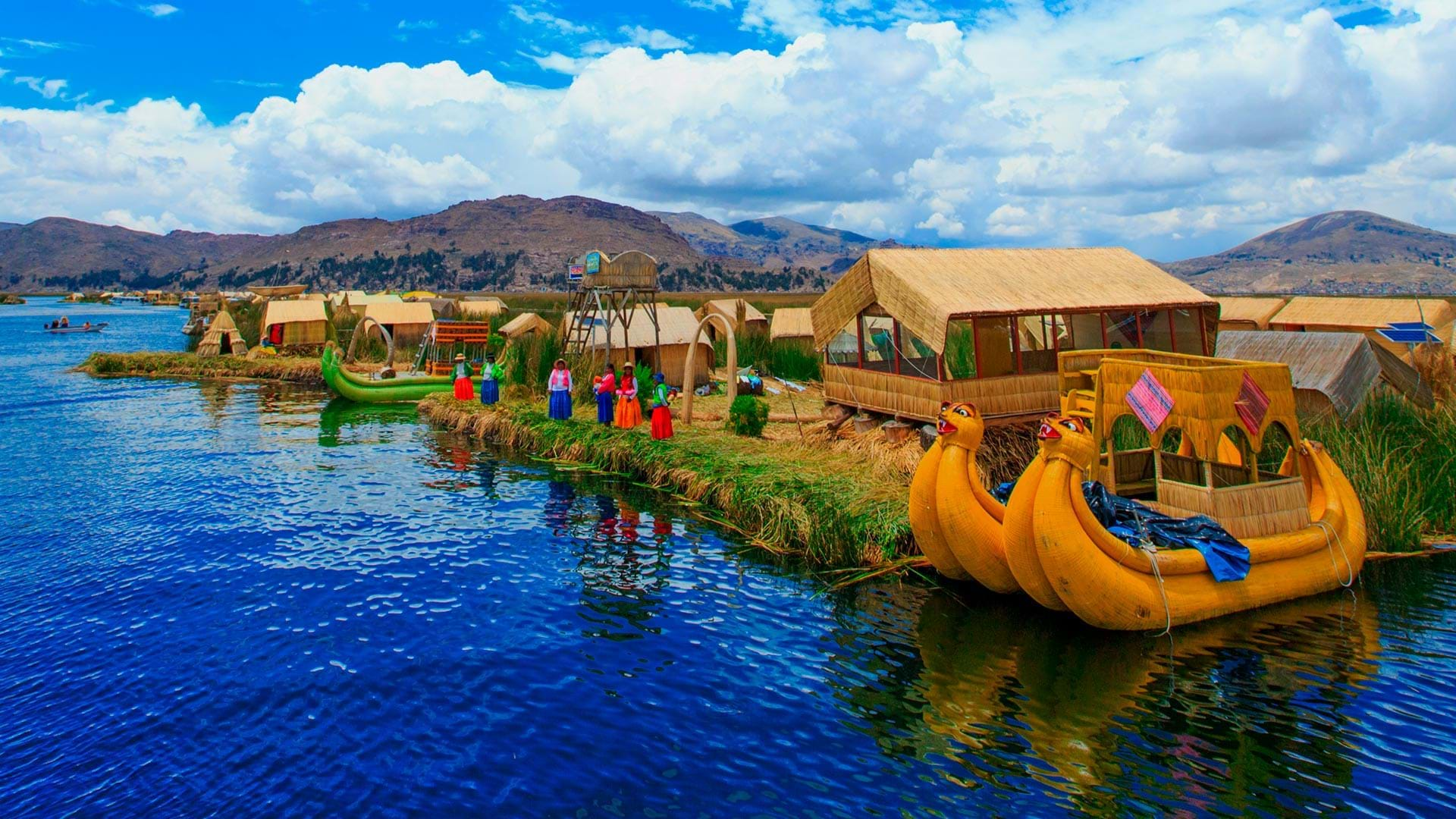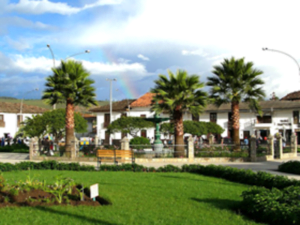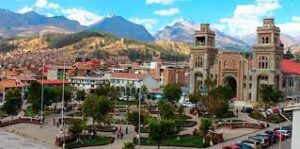MAIN TOURISTIC ATTRACTIONS

Location: The Department of Puno is located in the southeast of Perú, on the border with Bolivia.
Orography: The two elements that configure the relief of Puno are Lake Titicaca and the extensive and desolate altiplano located at more than 3.800 meters above sea level.
Climate: Cold and dry. The rainiest months are from December to March.
Area: 27.985 square kilómeters.
Capital: Juliaca. Located in the high altiplano at an altitude of 3.822 meters above sea level.
TOURISTIC OFFER
The City of Puno and surroundings
The City of Juliaca and surroundings
Parties and Folklore in the Lake Titicaca
The main tourist attractions of the Department of Puno is Lake Titicaca: located at 3.820 meters above sea level, with 194 km. Long and 65 km. this is one of the highest navigable lakes in the World. Its interest for tourism is found both in its natural beauty and in the possibility of taking different boat trips through its waters; in some of the Communities settled on its shores, facilities are offered to make possible the practice of experiential tourism: coexistence and knowledge of the traditional ways of life of the inhabitants of the Lake.
The importance of Lake Titicaca for Puno, as a tourist resources of the first order, i completes with the existence of numerous Inca and pre-Incas archaeological remains scattered throughout the Department, as well as with the great variety of colonial churches that exist in its populations.
THE CITY OF PUNO AND ITS SURROUNDINGS
Puno is the most important touristic city located on the shores of Lake Titicaca, being located at 3.830 meters above sea level. Its climate is semi-dry, very rigorous and extreme. With an average temperature of 9ºC, being especially cold during the winter months (temperatures well below 0°C in June, July and August); the rainy season runs between November and March.
Tourist Attractions of Puno, apart from Lake Titicaca:
- Plaza de Armas and Catedral
- Church of San Juan Bautista
- House of the Virrey Conde de Lemos
- Municipal Museum of Carlos Dreyer: pre-hispánic and colonial art
- Museum of the Typical Costume: folklore
- Museum Barco Yavari: naval history
- Huajsapata Park: natural viewpoint
- Uros Islands: artificial floating islands made of reeds
- Festivals and Traditional Dances
In the surroundings of Puno the main place of interest is the archaeological site of Sillustani: “chullpas” or funerary towers of the Inca and Colla cultures located 34 km. from Puno, on the shores of the Umayo Lagoon.
The city of Puno is the ideal port to visit the islands of Amantani y Taquile, and the natural starting point to access Bolivia. On the route to the Bolivian border it is possible to visit different towns settled on the shores of the Lake.
- Chucuito: 18 km. From Puno. It has two attractive colonial churches, Santo Domingo and La Asunción. It has an archaeological site, the Inca Uyo or Temple of the falos, dedicated to invoking fertility.
- Ilave: 56 km. Of the city of Puno, it is the second commercial center of the Department for its important Sunday fair. It preserves archaeological zones such as Jisquraya, Lalacota, Mullacani, Chek´a, Pukarani and Mulla Fasiri.
- Juli: 84 km. of Puno, was the most Jesuit training center for the missions of Paraguay and Bolivia. It has four beautiful colonial churches: La Asunción, San Pedro Mártir, Santa Cruz of Jerusalén and San Juan de Letrán. In the church of San Juan de Letrán there is a collection of 80 canvases from the Cusco School and its Windows are made of Huamanga stone. There is a popular fair every Thursday.
- Pomata: 108 km. from Puno, this town is famous for the Church of Santiago Apóstol of Nuestra Señora del Rosario; built in pink granite, the Windows of the church are made of transparent alabaster and inside it houses canvases from the Cusco and Flemish Schools.
THE CITY OF JULIACA AND ITS SURROUNDINGS
Juliaca is the most important city in the Department of Puno, ot has only commercial airport and it is an outstanding economic center. The interest of this city for tourism is scarce, except for the fact that it is a communications hub and for being the Gateway to the Capachica Peninsula, an ideal place to practice experiential tourism.
Places of interest in the city:
- Church of Santa Catalina
- Church of La Merced
- Convent of the Franciscanos Brothers
- Cerro Waynarroque.- Cristo Blanco: natural viewpoint
Tourism in the surroundings of Juliaca:
- Capachica: Located on thePenínsula of the same name, this tiny town sits on the shores of Lake Titicaca and constitutes the entrance to the Community of Llachón, Where it is possible to experience the sensations of experiential tourism, as well as being able to carry out different activities on the Lake:
- Visit the islands of the “authentic” Uros, less crowded than those of Puno
- Travel to the islands of Amantani, Taquile or Suasi, where it is also possible to practice experiential tourism
- To Practice water sports
- Lampa: small town 23 km. from Juliaca. It is called “Pink City” because of the color of its buildings. Tourist attractions: Colonial Church of Santiago Apóstol (Capilla de la Piedad), House of the painter Víctor Humareda, Cueva de los Toros (sculptures and funerary towers)
- Pucará: town located 62 km. From Juliaca, on the road to Cusco. Its main tourist attractions are its famous ceramics, and the sculptures of bulls made of this material. Its main square and the Church of Santa Isabel are well worth a visit, as well as the archaeological remain of the Pucara Culture.
- Capachica: Located on thePenínsula of the same name, this tiny town sits on the shores of Lake Titicaca and constitutes the entrance to the Community of Llachón, Where it is possible to experience the sensations of experiential tourism, as well as being able to carry out different activities on the Lake:
- Visit the islands of the “authentic” Uros, less crowded than those of Puno
- Travel to the islands of Amantani, Taquile or Suasi, where it is also possible to practice experiential tourism
- To Practice water sports
- Lampa: small town 23 km. from Juliaca. It is called “Pink City” because of the color of its buildings. Tourist attractions: Colonial Church of Santiago Apóstol (Capilla de la Piedad), House of the painter Víctor Humareda, Cueva de los Toros (sculptures and funerary towers)
- Pucará: town located 62 km. From Juliaca, on the road to Cusco. Its main tourist attractions are its famous ceramics, and the sculptures of bulls made of this material. Its main square and the Church of Santa Isabel are well worth a visit, as well as the archaeological remain of the Pucara Culture.
- Ayaviri: important commercial population at 3.928 meters above sea level. Obligatory point of passage on the road to Cusco, it is located 100 km. from Juliaca and has a beautiful colonial church.
FESTIVASS AND FOLKLORE ON LAKE TITICACA
Puno, known as the Flokloric Capital of Peru, is characterized by its rich and varied musical manifestations, where it more than 300 dances stand out. Among these dances the best knon are:
- La Wifala de Asillo. Quechua dance that evoques trial marriage
- Ichu Carnival: Aymara dance about love
- La Lamerada: In homage to the Virgin of Candelaria
- El Pujllay: Quechua dance of the carnaval of Santiago de Pupuja
- La Pandilla Puneña: Also typical of the carnaval parties.
- El Machu-Tusuj: Satirical dance of the fight against the oppressor
- El Kcajelo: A huayno dedicated to the manhood of horsemen
- La Diablada: Dedicated to the fight between god and evil.
The main folkloric manifestations within the Department of Puno are distributed throughout the year, the most important date of celebration being the following:
- Alacitas Feir: January 6, in Ilave.
- Festival of Payment to the Earth (“Pachamama” and “Pachatata”): The third Thursday of January, on the island of Amantani
- Fesivtal of the Virgin of the Candelaria: On february 2, it is the most important festival in Puno
- Carnival: In february, throughout the Department
- Feast of the Cross: May 2, in Huancané
- Internacional fair of Alacitas: On May 3. inPuno
- Aymara New Year: June 21, in Yunguyo
- Tayta Shanty: On July 25, on the Island of Taquile
- Patron Saint Festival of Santiago Apóstol: July 25 andl 26, in the towns of Huancané, Lampa y Pomata
- Anniversary of Juliaca: October 24, in Juliaca
- PunoTourist Week: From November 1 to 7 in Puno
- Staging oftheLegend of Manco Capac and Mama Ocllo: On November 5, on the islands of the Lake and Puno




